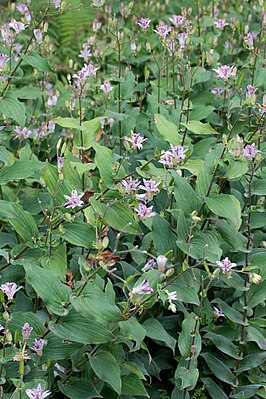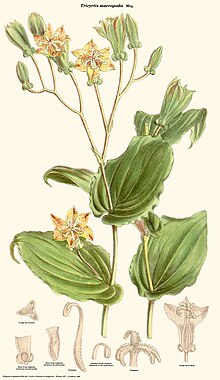Toad lilies
| Toad lilies | ||||||||||||
|---|---|---|---|---|---|---|---|---|---|---|---|---|

|
||||||||||||
| Systematics | ||||||||||||
|
||||||||||||
| Scientific name | ||||||||||||
| Tricyrtis | ||||||||||||
| Wall. |
The plant genus tricyrtis ( Tricyrtis ) belongs to the family of the lily family (Liliaceae). The 20 or so species are distributed in eastern Asia , many of which are rare and occur in small distribution areas.
description




Appearance and leaves
The Tricyrtis species grow as perennial herbaceous plants . Creeping, usually short or sometimes long rhizomes are formed as persistence organs . The upright or ascending stems are simple or sometimes branched at the top.
Many almost sessile leaves are arranged alternately on the stem. The simple, relatively thin leaf blades are elliptical to egg-shaped with mostly more or less stem-encompassing base and a pointed to pointed upper end. There is parallel veining and there are many leaf veins .
Inflorescences and flowers
The flowers are individually in the leaf axils or in thyrsoid , rarely racemose inflorescences .
The relatively conspicuous, bell-shaped or trumpet-shaped flowers are hermaphrodite, radial symmetry and threefold. The six unequal, free bracts are usually spread out or bent back at the upper end and usually not durable. The three outer bracts are sack-shaped or short spurred. The color of the bracts is white or yellow with purple spots. There are two circles with three stamens each. The stamens inserted at the base of the bracts are somewhat flattened and converge at the top to form a short tube. The basifix, outwardly curved anthers can move freely. The three carpels are fused to form an upper, three- chamber ovary. Each ovary chamber contains many ovules . The columnar stylus ends in three spread out scar lobes that are split in the upper area.
Fruits and seeds
The broad, cylindrical, triangular capsule fruits are septicidal and contain many seeds. The relatively small seeds are egg-shaped to spherical and flattened.
Systematics and distribution
The genus Tricyrtis was established in 1826 by Nathaniel Wallich in Tentamen Florae Napalensis Illustratae , p. 61. Type species is Tricyrtis pilosa Wall. , now a synonym of Tricyrtis maculata (D.Don) JFMacbr. The generic name Tricyrtis is made up of the Greek words tri for three and kyrtos for convex, this refers to the three sepals, which have a swollen base. Synonyms for Tricyrtis Wall. are: Compsoa D.Don , Compsanthus Spreng. , Brachycyrtis Koidz.
The Tricyrtis species are distributed in eastern Asia from the Himalayas via China to Taiwan , Japan and the Philippines (one species). Four species occur in the People's Republic of China, two of them only there. Six species are found in Taiwan , four of them only there. The center of biodiversity is Japan with around 13 species, 11 of which are only there.
The genus Tricyrtis belongs to the subfamily Calochortoideae within the family Liliaceae , formerly in Calochortaceae, Convallariaceae, Tricyrtidaceae, Uvulariaceae.
So far there have been two proposals by Masamune 1930 and Takahashi 1980 for the classification of the genus Tricyrtis . The four sections according to Takahashi 1980 are: Section Brachycyrtis (Koidz.) Kitag. & Koyama (with Tricyrtis macrantha , Tricyrtis macranthopsis , Tricyrtis ishiiana ), Flavae Masam. (with Tricyrtis ohsumiensis , Tricyrtis flava , Tricyrtis nana , Tricyrtis perfoliata ), Section Hirtae Masam. (with Tricyrtis formosana , Tricyrtis lasiocarpa , Tricyrtis ravenii , Tricyrtis hirta ) and section Tricyrtis Kitag. & Koyama (with Tricyrtis suzukii , Tricyrtis setouchiensis , Tricyrtis macropoda , Tricyrtis maculata , Tricyrtis affinis , Tricyrtis latifolia ). Molecular genetic studies only partially confirm this classification, but not enough data are available for a new classification.
According to Noriyuki Tanaka 2012 there are 20 types of Tricyrtis :
- Mountain toad lily ( Tricyrtis affinis Makino , Syn .: Tricyrtis macropoda subsp. Affinis (Makino) Kitam. , Tricyrtis affinis var. Albida Makino , Tricyrtis parviflora Dammer , Tricyrtis hirta var. Parviflora (Dammer) Masam. , Tricyrtis japonica var. Albida ( Makino) Masam. , Tricyrtis chiugokuensis Koidz. , Tricyrtis affinis var. Chiugokuensis (Koidz.) Ohwi , Tricyrtis affinis f. Albida (Makino) Okuyama , Tricyrtis macropoda var. Chiugokuensis (Koidz.) Ohwi. ): The homeland is Japan.
- Tricyrtis chinensis Hir.Takah. : This species, described in 2001, occurs in the Chinese provinces of Anhui , Fujian , Guangdong , Guangxi , Hunan , Jiangxi and Zhejiang.
- Tricyrtis dilatata Nakai : It occurs only in South Korea .
- Yellow toad lily ( Tricyrtis flava Maxim. ): This endemic occurs only in Miyazaki Prefecture on the Japanese island of Kyushu .
-
Taiwan toad lily ( Tricyrtis formosana Baker , Syn .: Compsoa formosana (Baker) Kuntze ): It occurs with two varieties only in Taiwan and Nansei-shoto :
- Tricyrtis formosana Baker var. Formosana (Syn .: tricyrtis stolonifera . Matsum , tricyrtis formosana var. Stolonifera .. (Matsum) Masam , tricyrtis kotoensis . G.W.Rob , tricyrtis formosana var. Grandiflora S.S.Ying ): Only in Taiwan and on Nansei- shoto before.
- Tricyrtis formosana var. Glandosa (T.Shimizu) TSLiu & SSYing (Syn .: Tricyrtis formosana f. Glandosa T.Shimizu , Tricyrtis ravenii C.I.Peng & Tiang ): It occurs only in northeastern and central Taiwan.
-
Bristly toad lily , also known as wire-haired toad lily or Japanese toad lily , ( Tricyrtis hirta ( Thunb. ) Hook. , Syn .: Uvularia hirta Thunb. , Compsoa hirta (Thunb.) Kuntze ): It occurs in two varieties in central and southern Japan.
- Tricyrtis hirta (Thunb.) Hook. var. hirta (Syn .: Tricyrtis japonica Miq. , Tricyrtis clinata J.F. Macbr . , Tricyrtis hirta var. minor Honda , Tricyrtis hirta var. saxicola Honda , Tricyrtis hirta var. albescens Makino , Tricyrtis hirta var. ramosissima Honda , Tricyrtis hirt . albescens (Makino) Hiyama , Tricyrtis hirta f. nivea Hiyama , Tricyrtis hirta f. atropurpurea Hisauti ): It occurs in central and southern Japan.
- Tricyrtis hirta var. Masamunei (Makino) Masam. ( Tricyrtis masamunei Makino ): It occurs only on the Japanese island of Kyushu .
- Tricyrtis imeldae Guthnick : It only occurs in Mindanao .
- Tricyrtis ishiiana (Kitag. & T.Koyama) Ohwi & Okuyama (Syn .: Tricyrtis macrantha var. Ishiiana Kitag. & T.Koyama , Tricyrtis ishiiana var. Surugensis Yamazaki ): It is endemic to the central-eastern part of the Japanese island of Honshu .
- Tricyrtis lasiocarpa Matsum. (Syn .: Tricyrtis formosana var. Lasiocarpa (Matsum.) Masam. , Tricyrtis formosana var. Amethystina Masam. , Tricyrtis formosana f. Amethystina (Masam.) T.Shimizu , Tricyrtis ovatifolia S.S.Ying , Tricyrtis formosana var. Ovatifolia (SSYing) SSYing ): It occurs only in western and southern Taiwan.
- Broad-leaved toad lily ( Tricyrtis latifolia Maxim. ): It is found in China and Japan.
- Large-flowered toad lily ( Tricyrtis macrantha Maxim. ): It occurs only on the Japanese island of Shikoku .
- Tricyrtis macranthopsis Masam. : This endemic occurs only on the Kii Peninsula in central Japan.
- Small-flowered toad lily ( Tricyrtis macropoda Miq. ): There are two forms in central and southern Japan.
- Soft-haired toad lily ( Tricyrtis maculata (D.Don) JFMacbr. , Syn .: Compsoa maculata D.Don , Compsanthus maculatus (D.Don) Spreng. , Tricyrtis elegans Wall. Nom. Nud., Tricyrtis pilosa Wall. , Disporum esquirolii H. Lév. , Tricyrtis esquirolii (H.Lév.) H.Hara ; Tricyrtis viridula Hir.Takah. ): It occurs from Nepal to southern China and thrives in China in forests and on forest edges at altitudes between 1000 and 1800 meters in the Chinese provinces Guangxi, Guizhou, Jiangxi, Yunnan and Zhejiang.
- Tricyrtis nana Yatabe : It occurs in south-central and southern Japan.
- Ohsumi toad lily ( Tricyrtis ohsumiensis Masam. ): This endemic occurs on the Japanese island of Kyushu only on the Ôsumi peninsula.
- Tricyrtis perfoliata Masam. : It occurs only in Miyazaki Prefecture on the Japanese island of Kyushu.
- Downy toad lily ( Tricyrtis puberula Nakai & Kitag. , Syn .: Tricyrtis pseudolatifolia Hir.Takah. & H.Koyama ): It occurs in northern and central China.
- Tricyrtis setouchiensis Hir.Takah. : It occurs on the Japanese islands of Honshu and Shikoku .
- Tricyrtis suzukii Masam. : It occurs only in northeastern Taiwan.
- Tricyrtis xianjuensis G.Y.Li, ZHChen & DDMa : It wasfirst describedin 2015 from Xinjiang .
use
Some Tricyrtis species, especially Tricyrtis formosana and Tricyrtis hirta and Tricyrtis varieties, are used as ornamental plants in parks and gardens. They are hardy in the temperate latitudes ( USDA hardiness zones 5 through 8).
swell
- Sophia Wan Pyo Hong, Stephen L. Jury: Phylogeny and Molecular Evolution of Tricyrtis (Liliaceae sl) Inferred from Plastid DNA matK Spacer Nucleotide Sequences. In: Journal of Plant Studies , Volume 1, Issue 2, 2012. ISSN 1927-0461 doi : 10.5539 / jps.v1n2p1 full text PDF. (Sections distribution and systematics)
- Noriyuki Tanaka: Taxonomic revision and diversification of the genus Tricyrtis (Liliaceae). In: Makinoa , ns, 10, 2012, pp. 1–152.
- Chen Xinqi, Hiroshi Takahashi: Tricyrtis , p. 151 - the same text online as the printed work , In: Wu Zheng-yi, Peter H. Raven (Ed.): Flora of China , Volume 24 - Flagellariaceae through Marantaceae , Science Press and Missouri Botanical Garden Press, Beijing and St. Louis, 2000. ISBN 0-915279-83-5 (sections Description, Distribution and Systematics)
- Ching-I Peng, Choon-Lin Tiang, Tsai-Wen Hsu: Tricyrtis ravenii (Liliaceae), a new species from Taiwan. In: Botanical Studies. Volume 48, 2007, pp. 357–364: (full text PDF; 666 kB) (sections description, distribution and systematics)
- Eckehart J. Jäger, Friedrich Ebel, Peter Hanelt, Gerd K. Müller (eds.): Excursion flora from Germany . Founded by Werner Rothmaler. tape 5 : Herbaceous ornamental and useful plants . Springer, Spektrum Akademischer Verlag, Berlin / Heidelberg 2008, ISBN 978-3-8274-0918-8 , pp. 738-739 .
Individual evidence
- ↑ a b c d e f Chen Xinqi & Hiroshi Takahashi: Tricyrtis , p. 151 - online with the same text as the printed work , In: Wu Zheng-yi, Peter H. Raven (ed.): Flora of China , Volume 24 - Flagellariaceae through Marantaceae , Science Press and Missouri Botanical Garden Press, Beijing and St. Louis, 2000. ISBN 0-915279-83-5
- ^ Tricyrtis at Tropicos.org. Missouri Botanical Garden, St. Louis, accessed February 18, 2013.
- ↑ a b c d e f g h i j k l m n o p q r s t u Rafaël Govaerts (Ed.): Degeneria. In: World Checklist of Selected Plant Families (WCSP) - The Board of Trustees of the Royal Botanic Gardens, Kew . Retrieved July 3, 2018.
- ^ Tricyrtis in the Germplasm Resources Information Network (GRIN), USDA , ARS , National Genetic Resources Program. National Germplasm Resources Laboratory, Beltsville, Maryland. Retrieved February 18, 2013.
- ↑ a b c d e f g h Walter Erhardt , Erich Götz, Nils Bödeker, Siegmund Seybold: The great pikeperch. Encyclopedia of Plant Names . Volume 2. Types and varieties, pp. 1790-1791. Eugen Ulmer publishing house , Stuttgart (Hohenheim) 2008, ISBN 978-3-8001-5406-7 .
- ↑ a b Gordon Cheers (Ed.): Botanica. The ABC of plants. 10,000 species in text and images . Könemann Verlagsgesellschaft, 2003, ISBN 3-8331-1600-5 , p. 896 .
Web links
Supplementary literature
- Masayuki Maki, Hiroko Morita, Syuji Oiki, Hiroshi Takahashi: The Effect of Geographic Range and Dichogamy on Genetic Variability and Population Genetic Structure in Tricyrtis Section Flavae (Liliaceae). In: American Journal of Botany. Volume 86, Issue 2, 1999, pp. 287-292, doi : 10.2307 / 2656945


